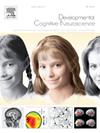Development of brain metastable dynamics during the equivalent of the third gestational trimester
IF 4.9
2区 医学
Q1 NEUROSCIENCES
引用次数: 0
Abstract
Metastability, a concept from dynamical systems theory, provides a framework for understanding how the brain shifts between various functional states and underpins essential cognitive, behavioural, and social function. While studied in adults, metastability in early brain development has only received recent attention. As the brain undergoes dramatic functional and structural changes over the third gestational trimester, here we review how these are reflected in changes in brain metastable dynamics in preterm, preterm at term-equivalent and full-term neonates.
We synthesize findings from EEG, fMRI, fUS, and computational models, focusing on the spatial distribution and temporal dynamics of metastable states, which include functional integration and segregation, signal predictability and complexity. Despite fragmented evidence, studies suggest that neonatal metastability develops over the equivalent of the third gestational trimester, with increasing ability for integration-segregation, broader range of metastable states, faster metastable state transitions and greater signal complexity. Preterms at term-equivalent age exhibit immature metastability features compared to full-terms. We explain and interpret these changes in terms of maturation of the brain in a free energy landscape and establishment of cognitive functions.
相当于妊娠晚期的脑亚稳态动力学的发展
亚稳态是动力系统理论中的一个概念,它为理解大脑如何在各种功能状态之间转换提供了一个框架,并支撑了基本的认知、行为和社会功能。在对成人的研究中,早期大脑发育的亚转移只是最近才受到关注。由于大脑在妊娠晚期经历了巨大的功能和结构变化,在这里,我们回顾了这些变化是如何反映在早产儿、足月早产儿和足月新生儿的脑亚稳态动力学变化中。我们综合了EEG、fMRI、fUS和计算模型的研究结果,重点研究了亚稳态的空间分布和时间动态,包括功能整合和分离、信号可预测性和复杂性。尽管证据不完整,但研究表明,新生儿亚稳态的发展相当于妊娠第三个月,亚稳态的整合-分离能力增强,亚稳态范围更广,亚稳态转换更快,信号更复杂。与足月早产儿相比,足月早产儿表现出不成熟的亚稳态特征。我们解释和解释这些变化在成熟的大脑在自由能量景观和建立认知功能。
本文章由计算机程序翻译,如有差异,请以英文原文为准。
求助全文
约1分钟内获得全文
求助全文
来源期刊

Developmental Cognitive Neuroscience
NEUROSCIENCES-
CiteScore
7.60
自引率
10.60%
发文量
124
审稿时长
6-12 weeks
期刊介绍:
The journal publishes theoretical and research papers on cognitive brain development, from infancy through childhood and adolescence and into adulthood. It covers neurocognitive development and neurocognitive processing in both typical and atypical development, including social and affective aspects. Appropriate methodologies for the journal include, but are not limited to, functional neuroimaging (fMRI and MEG), electrophysiology (EEG and ERP), NIRS and transcranial magnetic stimulation, as well as other basic neuroscience approaches using cellular and animal models that directly address cognitive brain development, patient studies, case studies, post-mortem studies and pharmacological studies.
 求助内容:
求助内容: 应助结果提醒方式:
应助结果提醒方式:


